Creating A Natural Habitat For Garden Frogs: Easy Steps for a Frog-Friendly Backyard
Garden frogs are cute and helpful creatures that can make your backyard more lively. They eat bugs and add a nice sound to your outdoor space. Making a frog-friendly garden is fun and easy.
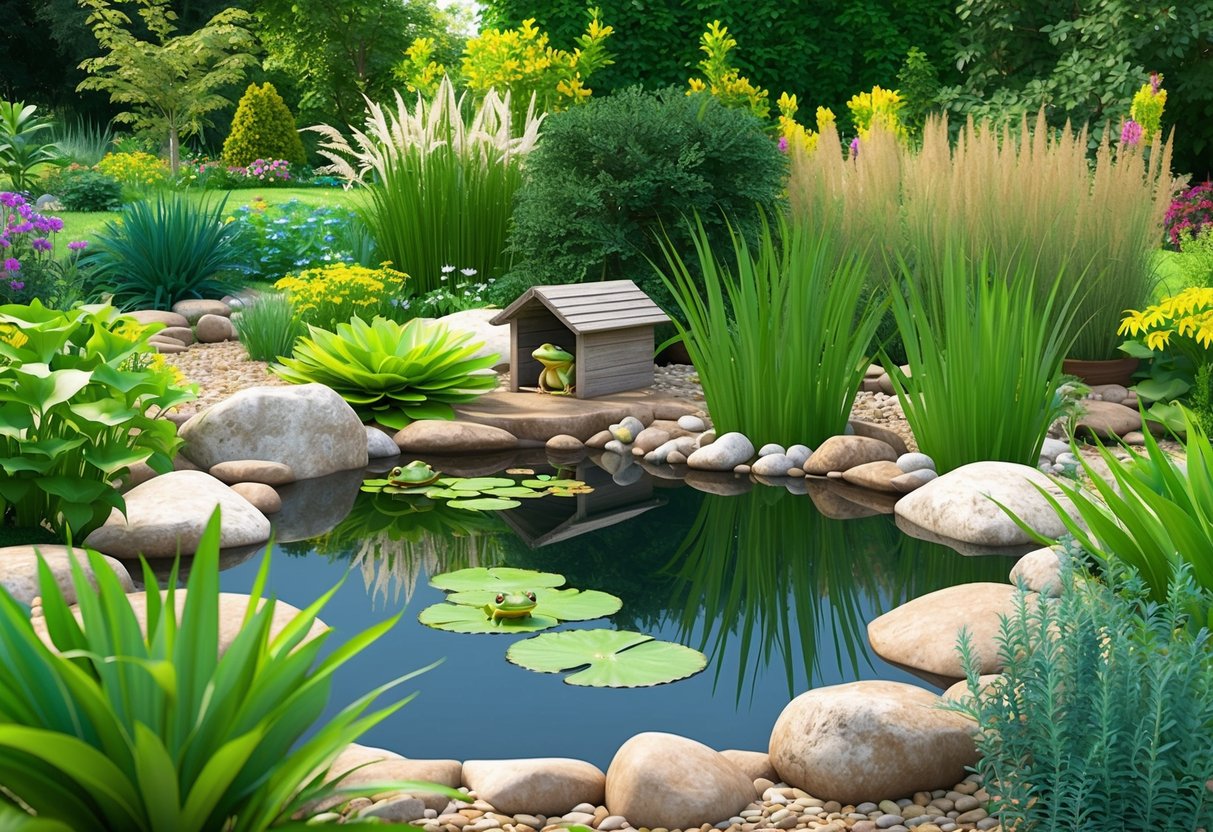
To create a natural habitat for garden frogs, add a small water feature, plant native vegetation, and avoid using chemicals in your yard. Frogs need water to lay eggs and stay moist. They also like places to hide and hunt for food.
By making your garden frog-friendly, you’ll help these cool animals thrive.
Your frog garden will be good for nature and fun for you to watch. You’ll see frogs hop around, hear them croak, and maybe even spot some tadpoles. It’s a great way to connect with nature right in your own backyard.
Key Takeaways
- Add a small pond or water feature to attract frogs to your garden
- Plant native plants to create hiding spots and attract insects for frogs to eat
- Skip harmful chemicals and pesticides to keep your frog habitat safe and healthy
Understanding Frogs and Their Habitat Needs
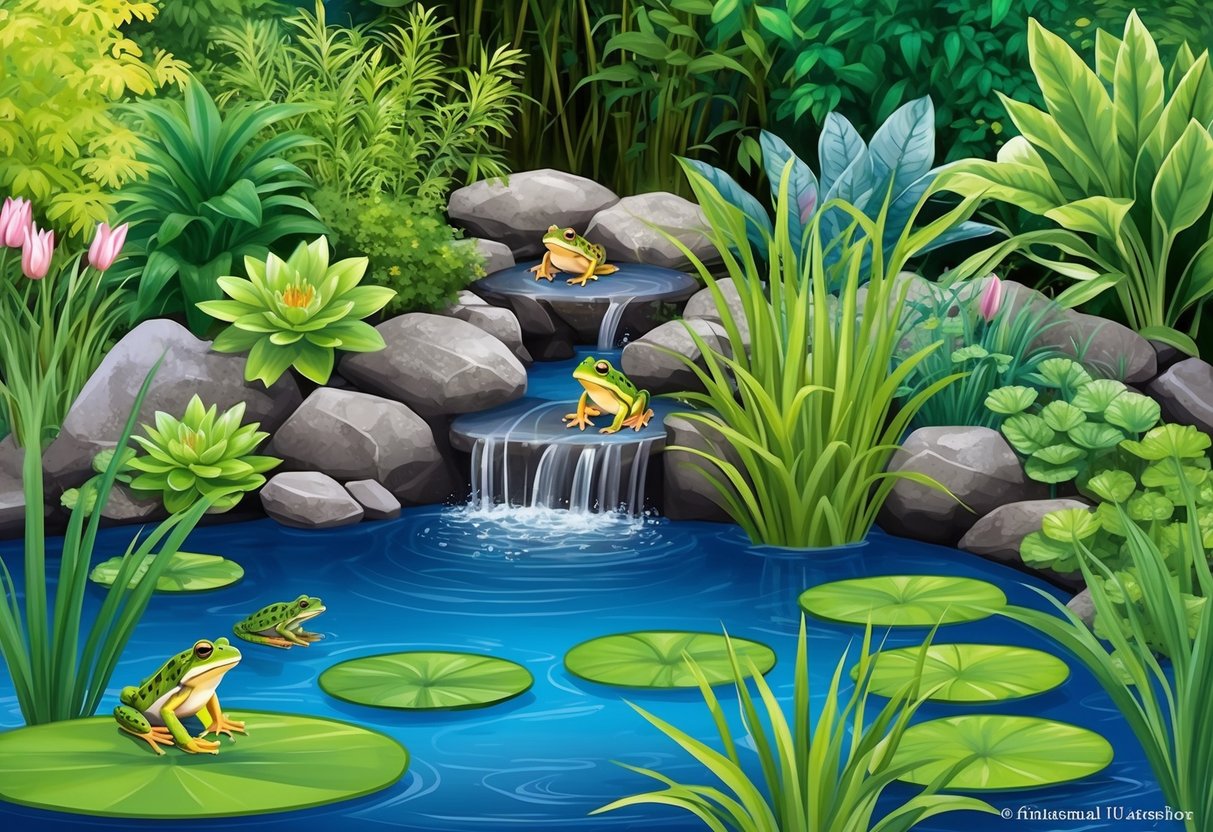
Frogs are amazing creatures with unique needs. They play a big role in nature and need specific things to thrive in your garden. Let’s explore what makes frogs tick and how you can help them feel at home.
The Biology of Frogs
Frogs are amphibians with smooth, moist skin. They breathe through their skin, which means they need clean, damp places to live. Most frogs start life as tadpoles in water, then change into land-dwelling adults.
Frogs come in many sizes and colors. Some are tiny, while others are quite large. Their eyes are often big and bulging, which helps them see well.
Many frogs can jump far and have long, strong legs. They use their sticky tongues to catch insects. Frogs are cold-blooded, so they rely on their surroundings to control their body temperature.
Natural Habitats of Frogs
Frogs live in many types of places. You can find them near ponds, streams, and wetlands. Some frogs even live in trees!
In the wild, frogs need:
- Clean water for breeding and staying moist
- Plants for shelter and shade
- Logs or rocks to hide under
- Insects and small creatures to eat
Frogs thrive in areas with a mix of water and land. They like spots with different heights and textures. This gives them places to hide, hunt, and lay eggs.
Importance of a Natural Habitat
A good habitat helps frogs stay healthy and happy. It lets them do all the things they need to do to live and grow.
Natural habitats support biodiversity. When you make a frog-friendly space, you help other animals too. Insects, birds, and small mammals all benefit.
Frogs eat lots of bugs, which helps control pests in your garden. They’re also food for other animals, making them an important part of the food chain.
By creating a natural habitat, you’re helping frogs survive. Many frog species are at risk, so every little bit helps. Your garden can become a safe haven for these helpful amphibians.
Planning Your Garden for Frogs
Creating a frog-friendly garden takes careful planning. You’ll need to think about your space, pick the right spot, and add features frogs love.
Assessing Your Space
Look at your yard with frog eyes. Frogs need both wet and dry areas. Check if you have sunny and shady spots. Measure how big your space is.
Think about what’s already there. Do you have trees, bushes, or open areas? Native plants are great for frogs. See if you can add some if you don’t have any.
Make a simple map of your yard. Mark where you might put frog-friendly features. This will help you plan better.
Choosing the Right Location
Frogs like quiet, damp spots. Pick a place away from busy areas in your yard. Look for shady areas. Frogs don’t like too much sun.
Find a spot near plants if you can. Frogs need cover to feel safe. If you don’t have plants, you can add some later.
Check the ground. Is it often wet or dry? Frogs need both. A mix is best. If it’s all dry, you’ll need to add water features.
Think about other animals too. Keep frog areas away from places where pets hang out.
Garden Features That Attract Frogs
Water is key for frogs. Add a small pond or fountain. Even a shallow dish can work. Make sure the water is clean and chemical-free.
Create hiding spots. Use rocks, logs, or thick plants. Frogs need places to rest and stay safe.
Plant native grasses and wildflowers. These attract bugs for frogs to eat. Mix tall and short plants for variety.
Add a compost pile. It will bring worms and insects that frogs like. Place it in a shady, damp spot.
Leave some areas wild. Don’t mow every part of your yard. Frogs love tall grass and natural areas.
Creating the Habitat
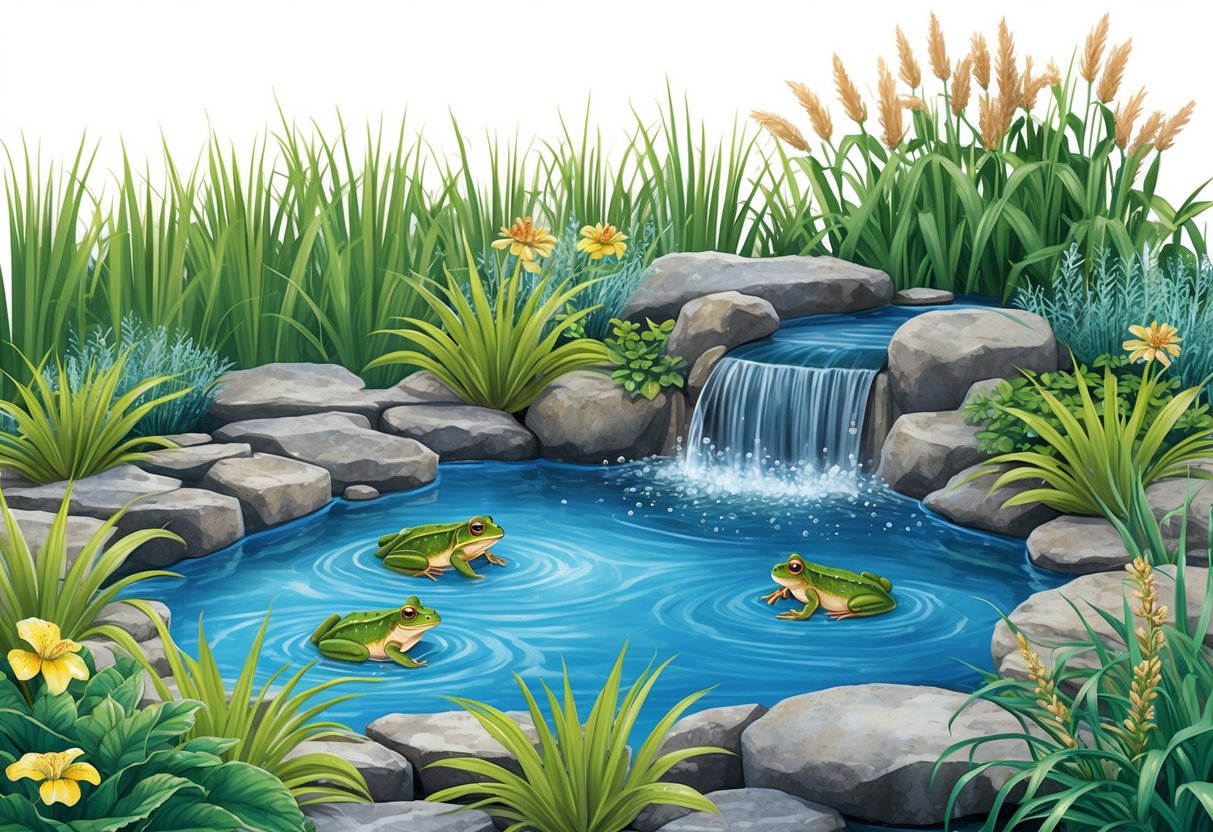
Making a frog-friendly habitat in your garden is easy and fun. You’ll need to focus on four key areas: water, food, shelter, and plants. Let’s look at how to set up each part of your frog paradise.
Providing Water Sources
Frogs need water to thrive. You can create a small pond or container filled with water to give them a place to live and breed. A shallow dish works well too.
Fill your water feature with clean, dechlorinated water. Change it often to keep it fresh. Add some rocks or logs in the water for frogs to rest on.
Remember, even a tiny water source can attract frogs. If you’re short on space, try a birdbath or a small fountain.
Natural Food Sources for Frogs
Frogs eat insects, so you’ll want to attract plenty of bugs to your garden. Don’t use pesticides – these can harm frogs and kill their food.
Plant native flowers and shrubs. These will bring in lots of tasty insects for your frogs.
You can also add a compost pile to your garden. This will attract worms and other small creatures that frogs love to eat.
Shelter and Hiding Spots
Frogs need safe places to hide from predators and the hot sun. You can create these easily with items from your yard.
Try these ideas:
- Stack rocks to make little caves
- Lay down old logs or branches
- Use clay pots turned on their sides
- Leave piles of leaves in quiet corners
Make sure to add hiding spots near your water source. Frogs like to have a quick escape route to water.
Safe Plants for Frogs
Choose plants that are safe for frogs and good for your local ecosystem. Native plants are always a great choice.
Some frog-friendly plants include:
- Ferns
- Mosses
- Water lilies
- Cattails
- Native grasses
Avoid using chemicals on your plants. Frogs have thin skin that easily absorbs toxins. Stick to natural gardening methods to keep your frogs healthy.
Plant in layers, with tall plants, medium shrubs, and ground cover. This creates a diverse habitat that frogs will love.
Maintaining the Frog-Friendly Garden
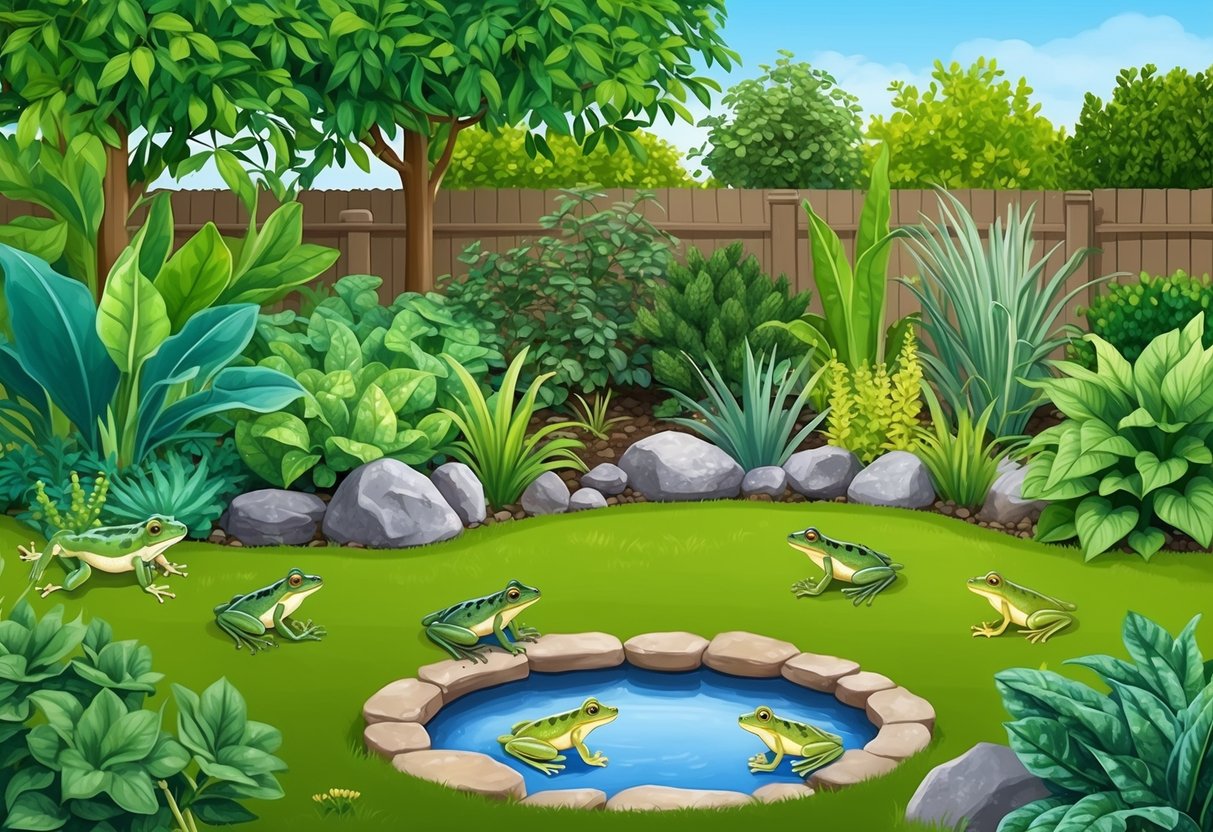
Keeping your frog habitat thriving takes some ongoing effort. You’ll need to balance regular upkeep with respecting the frogs’ needs throughout the year.
Regular Maintenance Tips
Keep your frog garden tidy, but not too tidy. Remove debris and fallen leaves occasionally, but leave some natural cover for frogs to hide under. Trim plants as needed, but avoid disturbing areas where frogs may be resting.
Check water features regularly. Top up ponds during dry spells and clear out excess algae. Clean fountains and shallow dishes to keep the water fresh.
Maintain diverse plantings. Replace any dead plants and add new native species to provide year-round habitat. This ensures frogs always have places to shelter and hunt.
Pesticides and Frogs
Avoid using chemical pesticides in your frog garden. These can harm or kill frogs and reduce their food sources. Instead, try these natural alternatives:
- Encourage beneficial insects like ladybugs
- Use physical barriers like row covers
- Try companion planting to deter pests
- Hand-pick larger pests when possible
If you must use pest control, choose organic options and apply them carefully away from water features and frog shelters. Always read labels to ensure products are safe for amphibians.
Helping Frogs Through the Seasons
Adapt your garden care to support frogs year-round.
In spring, provide shallow water for breeding. Create areas with fertile soil where frogs can lay eggs.
During summer, ensure water sources don’t dry up. Offer shady spots to help frogs stay cool.
In fall, leave some leaf litter as winter shelter.
For winter, create frost-free hiding spots. You can use:
- Buried flower pots
- Rock piles
- Logs or branches
These give frogs safe places to hibernate until spring arrives.
Common Challenges and Solutions
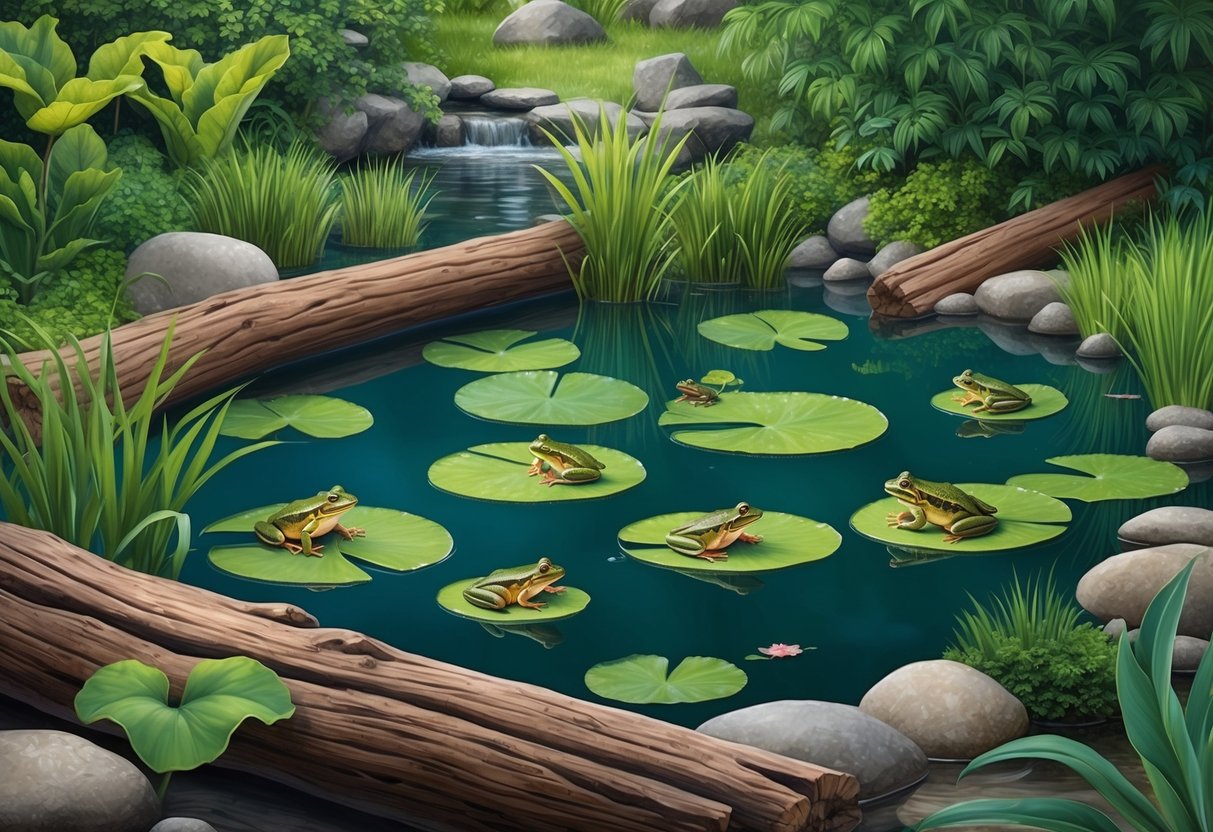
Creating a frog-friendly garden comes with some hurdles. Let’s look at ways to protect frogs, manage pests, and balance frog habitats with human needs.
Predators and Safety
Frogs face threats from many predators in gardens. Birds, snakes, and cats often hunt frogs.
To keep frogs safe, give them places to hide.
Add rocks and logs for shelter. Plant thick bushes and tall grasses. These give frogs spots to escape danger.
Use fencing to keep pets away from frog areas. Avoid using bright lights at night. These can make frogs easy targets for nocturnal hunters.
Make sure any water features have shallow edges. This lets frogs get in and out easily if predators come near.
Dealing With Pests
Some garden pests can harm frogs or their habitats.
Slugs and snails may eat frog eggs. Mosquitoes can spread diseases to frogs.
Don’t use chemical pesticides. These can poison frogs. Try natural pest control instead.
Encourage helpful insects like ladybugs and praying mantises. They eat pests without hurting frogs.
For mosquitoes, use moving water features. Mosquitoes can’t lay eggs in flowing water.
Remove standing water that’s not part of frog habitats. This cuts down on mosquito breeding spots.
Frogs and Human Interaction
Balancing frog needs with human use of the garden can be tricky.
Frogs may make noise at night, which some people find bothersome.
Create frog areas away from bedrooms or patios. This reduces noise issues.
Teach kids to enjoy frogs from a distance. Touching frogs can harm their sensitive skin.
When gardening, check for frogs before using tools. Move them gently if needed.
Avoid using chemicals on your lawn or garden. These can hurt frogs even if not applied directly to their habitat.
Contributing to Conservation
Creating a frog-friendly garden helps local amphibians. You can also take part in wider conservation efforts. These actions support frogs and their habitats beyond your backyard.
Educating Others
Share your love for frogs with friends and family.
Tell them about the important role frogs play in the ecosystem. Explain how frogs act as natural pest control by eating insects.
Host a frog-themed party or nature walk in your garden. Show guests your frog habitat and teach them how to make their own. Give out native plant seeds as party favors to help spread frog-friendly gardens.
Create fun, informative flyers about local frog species.
Post them in community spaces or share on social media. Include tips on how people can help protect frogs in their area.
Supporting Local Wildlife Initiatives
Look for frog conservation groups in your area.
Many organizations need volunteers for frog surveys and habitat restoration projects. You can help count frogs or clean up wetlands.
Donate to reputable wildlife charities that focus on amphibian conservation. Your money can fund research and protection efforts for endangered frog species.
Avoid using chemicals in your yard that might harm frogs. Choose natural pest control methods instead. Encourage your neighbors to do the same to create a safer neighborhood for frogs.
Developing Community Projects
Start a community frog pond project.
Work with your local park or school to create a frog-friendly water feature. Get kids involved in the planning and building process.
Organize a native plant exchange in your neighborhood.
Swap frog-friendly plants with others to increase habitat diversity. This helps create connected green spaces for frogs to thrive.
Plan a community clean-up day focused on local waterways. Remove trash and invasive plants that threaten frog habitats. Invite local experts to teach about the importance of healthy ecosystems for frogs.
Frequently Asked Questions
Creating a frog-friendly habitat involves several key elements. Let’s explore some common questions about setting up spaces for frogs in gardens, aquariums, and backyards.
How can I create a DIY frog house in my garden?
You can make a simple frog house using a clay pot.
Turn the pot on its side and bury it halfway in the ground. Place some damp moss inside for comfort. Make sure the entrance is facing away from direct sunlight.
You can also use logs or rocks to create natural hiding spots. Arrange them in a way that forms small caves or crevices where frogs can rest.
What are the essential elements of a frog habitat in an aquarium?
For an aquarium frog habitat, you need both land and water areas.
Use sloped gravel to create a beach-like area. Add plants, rocks, and logs for hiding spots.
Keep the water clean and use a filter. Provide a basking spot with a heat lamp. Feed your frogs a diet of insects and small fish.
How can I attract frogs to my backyard even if I don’t have a pond?
You can attract frogs without a pond by creating a shallow water source.
Use a large shallow dish or container filled with water. Change the water regularly to keep it fresh.
Plant native vegetation to attract insects for frogs to eat. Avoid using chemicals in your yard. Provide hiding spots with rocks, logs, and dense plants.
What are some creative ideas for setting up an outdoor frog habitat?
Create a mini wetland using a buried plastic tub.
Fill it with water and aquatic plants. Add a small pump for water movement.
Build a frog-friendly rock garden. Use various sizes of rocks to create crevices. Plant moss and small ferns between the rocks for a natural look.
What do I need to know to make a pet-friendly frog habitat at home?
For a pet frog habitat, research the specific needs of your frog species.
Most need a terrarium with both land and water areas. Use a substrate that holds moisture, like coconut fiber.
Add live or artificial plants for hiding. Keep the habitat clean and mist it regularly for humidity. Feed your frog a diet of crickets and other insects.
Can you provide tips for a successful garden frog habitat project?
Start small and expand over time. Begin with a water source and some native plants.
Add hiding spots like logs and rocks.
Be patient. It may take time for frogs to find your habitat. Avoid using pesticides or chemicals in your garden.
Create different levels in your habitat for variety.
